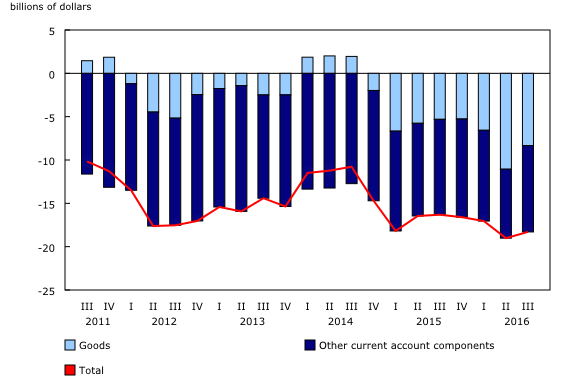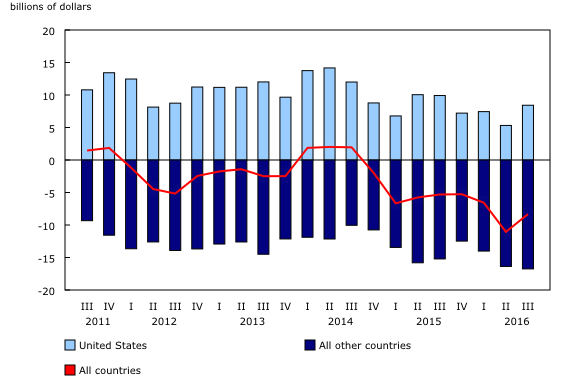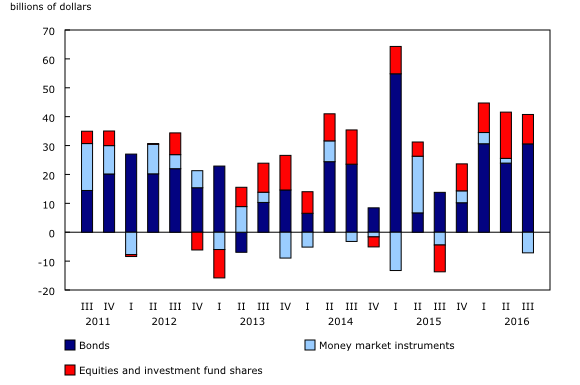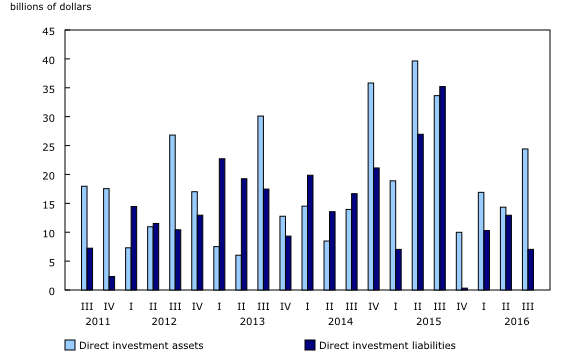Canada's balance of international payments, third quarter 2016
Archived Content
Information identified as archived is provided for reference, research or recordkeeping purposes. It is not subject to the Government of Canada Web Standards and has not been altered or updated since it was archived. Please "contact us" to request a format other than those available.
Released: 2016-11-29
-$18.3 billion
Third quarter 2016
Canada's current account deficit (on a seasonally adjusted basis) narrowed $0.7 billion in the third quarter to $18.3 billion, following three straight quarterly increases.
In the financial account (unadjusted for seasonal variation), strong foreign investment in Canadian corporate bonds led the inflow of funds in the quarter.
Current account
Overall deficit on trade in goods narrows
The deficit on international trade in goods narrowed $2.7 billion to $8.3 billion in the third quarter, following a record deficit of $11.1 billion in the second quarter. Exports outpaced imports as exports saw the highest growth since the first quarter of 2014.
On a geographical basis, the goods surplus with the United States increased $3.1 billion to $8.4 billion, led by stronger exports of energy products. In contrast, the deficit with non-US countries rose $0.4 billion to $16.8 billion, mostly reflecting a large import of industrial machinery, equipment and parts from South Korea destined for the Hebron offshore oil project in Newfoundland and Labrador.
Total exports of goods increased $5.9 billion to $130.1 billion in the third quarter. Energy products were the major contributor with exports up $2.3 billion on higher prices and volumes. In addition, exports of metal and non-metallic mineral products increased by $1.0 billion, mostly from higher prices. Consumer goods were up $0.7 billion on higher volumes, following a $1.6 billion reduction in the second quarter.
Total imports of goods rose $3.2 billion to $138.4 billion. The largest increase was in industrial machinery, equipment and parts, up $2.6 billion on higher volumes. Energy products and motor vehicles and parts also contributed to the gain, with both categories posting a $0.5 billion rise in the quarter. In contrast, aircraft and other transportation equipment and parts fell $1.4 billion on lower volumes, following a $0.9 billion increase in the previous quarter.
Trade in services deficit edges down
The overall deficit on international trade in services edged down $0.2 billion to $5.3 billion in the third quarter. This was the sixth consecutive quarterly reduction in the services deficit, mostly led by a lower travel deficit. Since the first quarter of 2015, the services deficit has narrowed by $1.0 billion.
The travel deficit was down $0.1 billion to $3.5 billion in the third quarter. Non-residents increased their spending in Canada as a result of more visits during the quarter. This was partially offset by larger payments made by Canadians travelling abroad. The travel deficit has diminished by $1.3 billion since the first quarter of 2015.
Changes in the transportation services deficit and the commercial services surplus were marginal in the quarter.
Deficit on investment income expands
The investment income deficit increased $1.6 billion to $3.5 billion in the third quarter. Profits earned by foreign direct investors on their Canadian assets were up $1.4 billion, nearly returning to 2015 year-end levels. Meanwhile, profits earned by Canadian direct investors on their assets abroad were largely unchanged.
Payments on foreign holdings of Canadian securities increased $0.3 billion in the third quarter, following a decline in the second quarter. Revenues from holdings of foreign securities were up by $0.1 billion.
Financial account
Foreign portfolio investment in Canada focuses on corporate securities
Foreign investment in Canadian securities amounted to $33.6 billion in the third quarter, a third consecutive quarter of strong investment led by acquisitions of corporate bonds. Foreign acquisitions of Canadian bonds reached $30.6 billion, with nearly two-thirds in new issues of corporate bonds denominated in foreign currencies. Foreign purchases of federal government bonds on the secondary market also contributed to the inflow of funds in the quarter.
Foreign investors withdrew $7.1 billion of funds from the Canadian money market in the quarter, mainly provincial government and corporate paper. At the same time, they added $10.2 billion of Canadian equities to their holdings, following a $16.0 billion investment in the second quarter. Foreign investment in Canadian equities was led by purchases on the secondary market. Canadian stock prices were up by 4.7% and the Canadian dollar depreciated against its US counterpart by 1.2 US cents in the quarter.
Canadian investment in foreign securities slows
Canadian investors acquired $8.0 billion of foreign securities in the third quarter, down from a $13.8 billion investment in the second quarter. The investment activity was in foreign shares as Canadian investors reduced their holdings of foreign debt securities during the quarter.
Canadian purchases of foreign shares were $11.7 billion, led by acquisitions of non-US foreign shares. At the same time, Canadian holdings of foreign debt securities were down by $3.7 billion, mainly non-US foreign bonds. The divestment in foreign debt securities was the highest in more than five years.
Direct investment assets increase
Transactions in direct investment assets totalled $24.4 billion in the third quarter, up from $14.3 billion in the second quarter. The bulk of the investment in the quarter was in the form of equity instruments. Two-thirds of the direct investment abroad was related to merger and acquisition activities in the United States.
Direct investment liabilities rose $7.0 billion in the third quarter, lower than the first two quarters of the year. Equity investment made by foreign parents in Canadian affiliates accounted for all of the increase in the quarter as there was a reduction in debt liabilities of Canadian affiliates to their foreign parents. In the first three quarter of 2016, direct investment from abroad totalled $30.3 billion, compared with $69.2 billion for the same period in 2015.
Other investment generates an inflow of funds
The other investment category of the financial account generated a net inflow of $7.7 billion in the third quarter. An increase in currency and deposits held by non-residents in Canada, mainly transactions of Canadian banks with their foreign affiliates and branches, was partially offset by a gain in both loans and currency and deposits held by Canadians abroad.
Note to readers
Revisions
Annual and quarterly data have been revised for the reference years 2013 to 2015. This is in keeping with the general policy to revise national accounts statistics at the time of the third quarter data release. In general, the revisions reflect more current sources of information coming from annual surveys and administrative data.
Definitions
The balance of international payments covers all economic transactions between Canadian residents and non-residents in three accounts: the current account, the capital account and the financial account.
The current account covers transactions in goods, services, compensation of employees, investment income and secondary income (current transfers).
The current account data in this release are seasonally adjusted. For information on seasonal adjustment, see Seasonally adjusted data – Frequently asked questions.
The capital account covers capital transfers and transactions in non-produced, non-financial assets.
The financial account covers transactions in financial assets and liabilities.
In principle, a net lending (+) / net borrowing (-) derived from the sum of the current and capital accounts corresponds to a net lending (+) / net borrowing (-) derived from the financial account. In practice, as data are compiled from multiple sources, this is rarely the case and gives rise to measurement error. The discrepancy (net errors and omissions) is the unobserved net inflow or outflow.
For more information on the balance of payments, consult the Frequently asked questions section in the System of macroeconomic accounts module of our website. The module also presents the most recent balance of payments statistics.
Real-time CANSIM table
Real-time CANSIM table 376-8105 will be updated on December 5. For more information, consult the document, Real-time CANSIM tables.
Next release
Balance of international payments data for the fourth quarter of 2016 will be released on March 1, 2017.
Products
The Methodological Guide: Canadian System of Macroeconomic Accounts (13-607-X) is available.
The User Guide: Canadian System of Macroeconomic Accounts (13-606-G) is also available. This publication will be updated to maintain its relevance.
Contact information
For more information, contact us (toll-free 1-800-263-1136; 514-283-8300; STATCAN.infostats-infostats.STATCAN@canada.ca).
To enquire about the concepts, methods or data quality of this release, contact Denis Caron (613-808-2278; denis.caron@canada.ca), International Accounts and Trade Division.
- Date modified:





